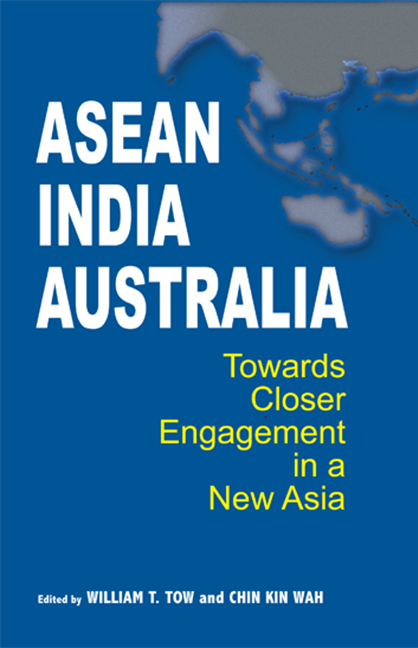Book contents
- Frontmatter
- Contents
- Preface
- Contributors
- List of Abbreviations
- Introduction
- Part I Emerging Regional Security
- Part II Energy Security
- Part III Climate Change
- Part IV Maritime Security
- 11 Australia and Maritime Security in the Northeast Indian Ocean
- 12 ASEAN Maritime Security Perspectives: Enduring Partnerships
- 13 Maritime Security Triangulation of ASEAN-Australia-India: An Indian Perspective
- 14 Governance in Australian Discourse
- 15 ASEAN Charter and Perspectives of Governance and Democracy in Asia
- 16 The Problem of Governance in India
- Part V Law Enforcement/Combating International Crime
- Conclusion
- Bibliography
- Index
11 - Australia and Maritime Security in the Northeast Indian Ocean
from Part IV - Maritime Security
Published online by Cambridge University Press: 21 October 2015
- Frontmatter
- Contents
- Preface
- Contributors
- List of Abbreviations
- Introduction
- Part I Emerging Regional Security
- Part II Energy Security
- Part III Climate Change
- Part IV Maritime Security
- 11 Australia and Maritime Security in the Northeast Indian Ocean
- 12 ASEAN Maritime Security Perspectives: Enduring Partnerships
- 13 Maritime Security Triangulation of ASEAN-Australia-India: An Indian Perspective
- 14 Governance in Australian Discourse
- 15 ASEAN Charter and Perspectives of Governance and Democracy in Asia
- 16 The Problem of Governance in India
- Part V Law Enforcement/Combating International Crime
- Conclusion
- Bibliography
- Index
Summary
Maritime security is vital to Australia and its neighbours in the ASEAN-Australia-India “triangle” — or the area of the northeast Indian Ocean. It has become a leading sphere for the construction of deeper forms of security cooperation. Nonetheless, both the “region” in question and the topic of maritime security itself are underdeveloped ideas in the context of rapidly developing relationships. Therefore, the approach pursued in this chapter focuses on four themes. First, the maritime nature of the area's geography is established. Second, different perspectives on maritime security are introduced, with an emphasis on non-traditional factors, including responses to the post-9/11 threat of terrorism in the maritime domain. Third, Australia's maritime security engagement activities in the northeast Indian Ocean area are outlined. And finally, the ever present strategic considerations bearing on maritime security within the “triangle” area are considered, including the consequent strategic dilemmas facing Australia.
Maritime Geography and Characteristics
There are three questions that need to be posed with respect to the geography of the ASEAN-Australia-India area. Firstly, and most fundamentally: Is the northeast Indian Ocean area distinct in geopolitical terms? Certainly, the area cannot usefully be thought of as a region or subregion in and of itself. However, the same argument can be applied to the Indian Ocean rim in its totality, and even, to some extent, to Southeast Asia. This is particularly the case with regard to the large physical expanses involved, and the geographical, cultural, ethnic, religious, political, and economic diversity inherent in those so-called “regions”. The Indian Ocean rim, for example, encompasses numerous identifiable regions and subregions across three continents. Nevertheless, it should be noted that India does conceive of the Indian Ocean rim as a region, perhaps understandably reflecting its central geographic position and desire for wider influence.
Although Southeast Asia is slightly more compact physically, it also is extremely diverse, possessing only limited common characteristics of the types noted above. In geopolitical terms, Southeast Asia's lack of homogeneity has been exacerbated by the expansion of ASEAN to include Burma* and Indochina, adding a starker contrast between the more continental preoccupations of the newer members, and the maritime outlook of the peninsular and archipelagic states.
- Type
- Chapter
- Information
- ASEAN-India-AustraliaTowards Closer Engagement in a New Asia, pp. 185 - 202Publisher: ISEAS–Yusof Ishak InstitutePrint publication year: 2009



